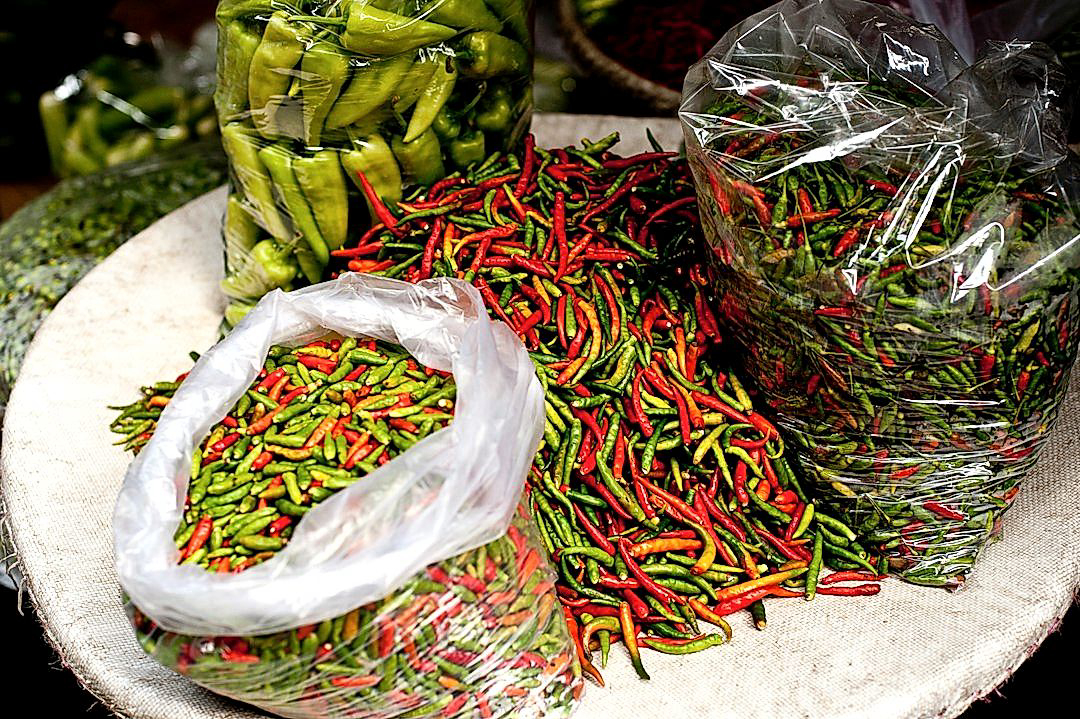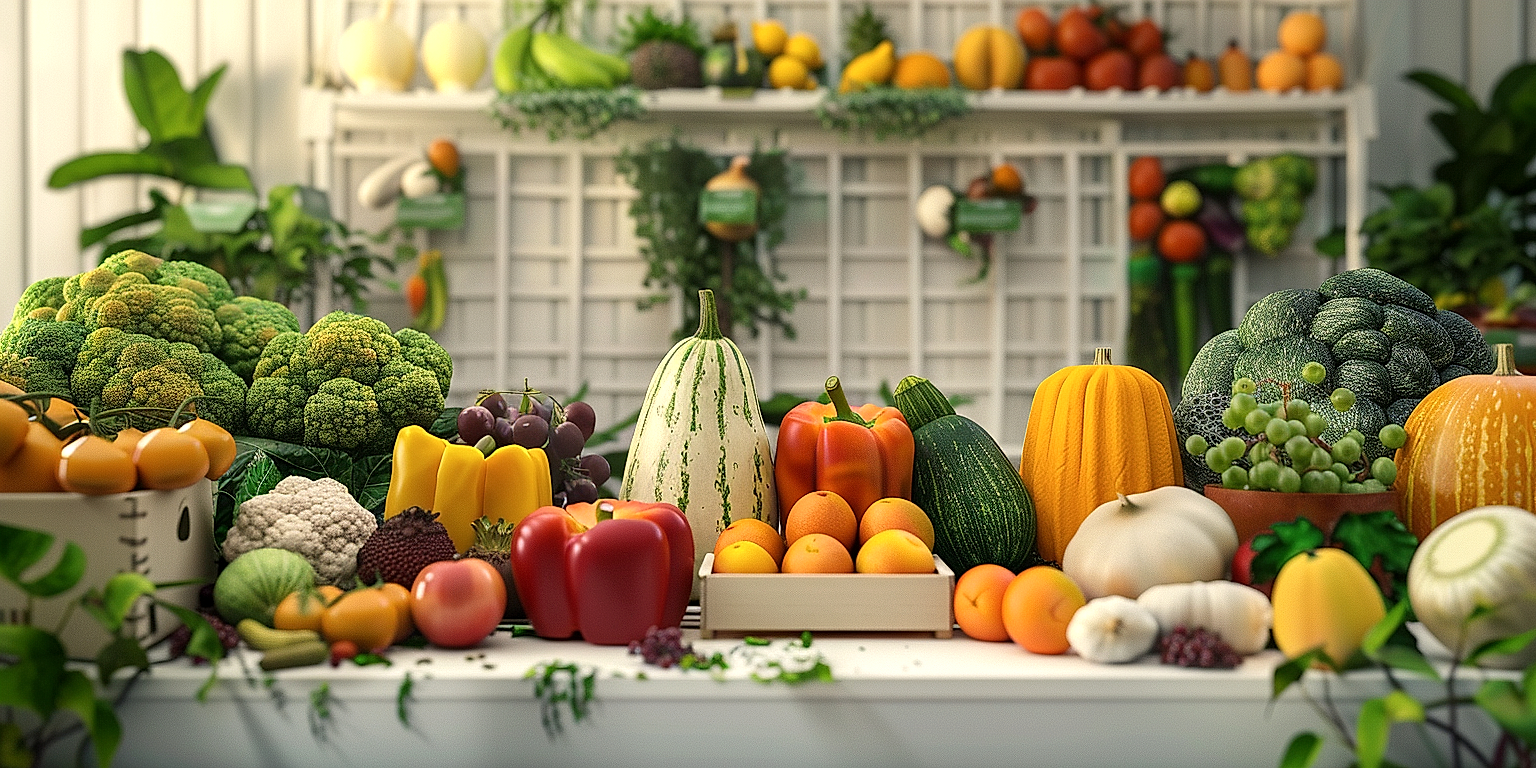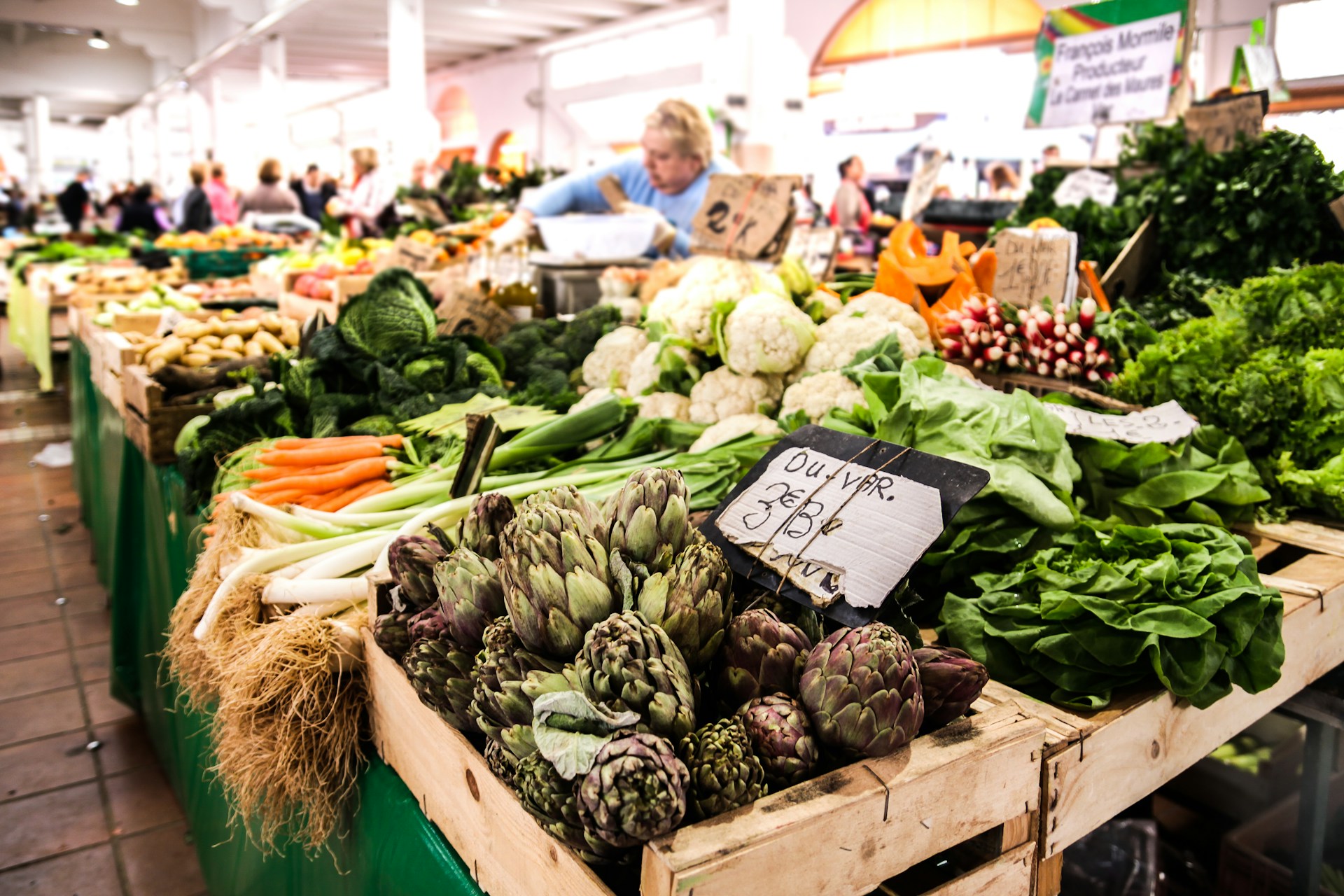In the domain of retail sales, attention-grabbing presentation is key to enticing customers and enhancing product appeal.
Well-arranged merchandise, specifically in the category of fresh produce, can increase customer interest and influence purchasing behavior.
Traditional, monotonous ways of organizing these goods are commonplace, but can often be overlooked by the consumer.
With an inventive approach, however, it is possible to transform a mundane display into a captivating focal point.
This, in turn, boosts the potential for sales and customer satisfaction.
This particular piece aims to spark fresh insights on implementing inventive designs in produce merchandising.
Contents
- Creative Display Ideas For Produce Merchandising
- 1. Fruit Pyramids with Tropical Leaves as a Backdrop
- 2. Shadow boxes for highlighting specialty or organic produce.
- 3. Artful Chalkboard Signs with Stylized Produce Drawings
- 4. Market baskets displaying region-specific fruits and vegetables.
- 5. Color gradient displays from light to dark produce.
- 6. Interactive, pick-your-own vegetable patch displays.
- 7. Cooler Displays for Exotic, Rare, or Luxury Fruits
- The Bottom Line
Creative Display Ideas For Produce Merchandising
1. Fruit Pyramids with Tropical Leaves as a Backdrop
One creative display idea that can significantly boost the appeal of your produce section is the use of fruit pyramids.
The concept involves stacking fruits like oranges, apples, or mangoes in a pyramid-like structure, which not only adds an attractive visual element but also showcases the freshness and quality of your fruits.
A well-constructed fruit pyramid can be an eye-catching masterpiece, drawing customers into your produce section and piquing their interest.
The fruit pyramid also offers a wonderful opportunity to introduce a variety of colors into your display, which can make your produce section visually appealing.
Pairing this with a tropical leaves backdrop can further enhance the aesthetic appeal of the display.
Such a backdrop creates a natural, lush, and tropical ambience, complementing the vibrant colors of the fruits and creating a striking contrast.
The tropical leaves backdrop creates a theme that is both refreshing and intriguing, making customers feel as if they are selecting fruits straight from a tropical orchard.
Apart from the aesthetic aspect, this display method brings a certain tropical feel to your produce section, which can entice customers to try out fruits they might not usually buy.
This can lead to increased sales of tropical and exotic fruits, enhancing your store’s overall profitability.
Ensure your fruit pyramid is stable and safe for customers to select from, preventing any accidental toppling or damage to the fruits.
Another key point is to regularly maintain both the fruit pyramid and the backdrop.
The fruits need to be checked for quality, removing any spoilt fruits and replenishing the pyramid as needed to maintain its attractive appearance.
The same applies to the backdrop, which requires regular cleaning and care to remain fresh and eye-catching.
Rotating the fruits based on seasonality is another strategy that can be employed.
This ensures you always have the freshest produce on display and keeps the concept interesting and dynamic as customers can look forward to new types of fruit in the pyramid each season.
By employing sound strategies and maintaining high standards, a fruit pyramid with a tropical leaves backdrop can significantly enhance your produce merchandising and set you apart from the competition.
2. Shadow boxes for highlighting specialty or organic produce.
Shadow boxes have long been utilized in retail and museum settings to call attention to special items within a display.
Their distinctive, three-dimensional design and their ability to add depth to any display make them a highly effective tool for merchandising.
By using them in the produce department, you’re not only creating a visually stimulating presentation, but also spotlighting the unique specialty or organic produce you offer.
The glass or clear plastic front of a shadow box works to protect the produce, while still allowing customers to view it.
This is especially useful for delicate or easily damaged items, such as organic fruits and vegetables that may not have the protective pesticides conventional produce does.
Highlighting these specialty items in shadow boxes also sends a subtle message to the consumers.
It implies that these products are worth their attention, and, perhaps, their premium price, because they’re displayed in such a distinctive manner.
With proper lighting, the shadow box approach can dramatically enhance the visual appeal of your fruit and vegetables.
Lighting plays a key role in bringing out the rich, vibrant colors of your produce.
It’s important to consider the backdrop color of your shadow box as well, to ensure it complements the displayed items.
When it comes to organizing the produce within the shadow box, there’s a lot of room for creativity.
For instance, one can arrange the produce by color, size, or type, creating a sort of still-life artwork with your produce.
The shadow box arrangement enables you to tell a story – the farm-to-table journey of your produce, or the efforts your store undertakes to source locally or organically.
By selecting the most visually interesting fruit or vegetables to feature, you create a compelling visual draw that can help to differentiate your display from typical supermarket offerings.
It would be a worthwhile strategy to rotate the items in your shadow boxes regularly, to keep the display fresh and engaging for your customers.
Finally, keep in mind that consistency is key in any display.
Items within your shadow boxes should be replenished regularly to keep the display at its best, as nothing drags down the appeal of a display faster than an empty or unattended box.
3. Artful Chalkboard Signs with Stylized Produce Drawings
As a produce merchandiser, your challenge is to capture the attention of shoppers and invite them to explore your fresh goods.
Amidst a sea of colorful fruits and vegetables, a unique and striking technique to achieve this could be through the use of artful chalkboard signs.
Imagine walking into a market and being greeted not only by the freshness of the produce available, but also by bold, hand-drawn illustrations of brightly colored fruits and vegetables, coupled with aesthetically pleasing typography that describes the produce and displays their prices.
These stylized signs could serve several purposes within your produce stand or store.
Firstly, they can be an excellent way of highlighting seasonal or special products.
Instead of simply relying on the innate beauty of your produce, a visually appealing chalkboard sign beside a pile of oranges, for example, with an attractive illustration of the fruit and the words Juicy and Fresh! written in swirling letters could elevate the perceived value and draw customers in.
Using chalkboards in your display also speaks to a more rustic, homegrown atmosphere, which ties perfectly into the concept of fresh produce and the farm-to-table movement.
They also lend themselves to versatility and ease of change, compared to printed signs, as the chalk can easily be wiped away and replaced with a new illustration or statement as needed.
The advantage of using this creative display idea is that it isn’t limited to just large signs.
Chalkboard labels can be utilized for individual products, allowing for easy identification and pricing; artful illustrations can bring a touch of creativity and visual appeal to something as routine as pricing or categorization.
Moreover, chalkboard signs with stylized produce drawings bring out a sense of personality in your produce merchandising, allowing you to connect with your customers on a more personal level.
They offer the opportunity to communicate your brand vision, share information about your products, and even tell a story, all while adding an element of art and beauty to your displays.
Whether it’s displaying the name of a rare, exotic fruit using fancy calligraphy, or illustrating the farm where your fresh produce comes from, the possibilities of using chalkboard signs in merchandising are truly abundant.
However, to achieve this, you’ll need either a flair for DIY projects or the services of an artist skilled in chalkboard art, as the effectiveness and success of this creative merchandising idea largely depends on the quality of the artwork.
In conclusion, incorporating artful chalkboard signs with stylized produce drawings into your merchandising strategy is a tried and true method for capturing customer attention and enhancing their shopping experience.
4. Market baskets displaying region-specific fruits and vegetables.
Market baskets serve as a fantastic method for displaying region-specific fruits and vegetables.
These baskets not only provide an eye-catching display but also offer the customers a feel for the origin of the produce.
By labeling each basket with the region of origin, customers gain an appreciation for the diversity of your produce.
This is a great opportunity to educate people about the importance of local and sustainable farming.
Using market baskets to display region-specific produce encourages customers to explore varietals they might not otherwise try.
Furthermore, these baskets can be creatively arranged to catch the eye of customers as they shop.
Some merchandisers combine fruits and vegetables in a single basket, creating a colorful and appealing presentation.
Others choose to separate their produce, focusing on highlighting individual items’ unique characteristics.
Whatever the choice, these baskets, when used correctly, can greatly enhance the visual appeal of your market’s produce section.
It’s important to note that while these baskets are enjoyable, they also serve a practical purpose.
They are great for keeping produce fresh and undamaged, as they allow for proper air circulation.
Baskets also make it easy to continually rotate your produce, ensuring that the freshest items are always at customer eye level.
Products at the bottom of the basket are then gradually rotated to the top once the top layer is sold, thus maintaining the freshness of the stock.
Bottom line, using market baskets to showcase region-specific produce not only benefits your customers but also your business.
When customers see the diverse produce, understand where it is grown, and appreciate the attractive display, they’re more likely to make a purchase.
The success of this technique will depend largely on your creativity, as well as the diverse range of region-specific fruits and vegetables you can source.
5. Color gradient displays from light to dark produce.
Everyone who has ever walked into a grocery store knows that the first thing that catches their attention are the vibrant colors of the produce section.
The fresh greens, reds, and purples of fruits and vegetables can be strategically arranged to create a color gradient display.
This kind of merchandising tactic can be eye-catching and encourage customers’ exploration of the produce area.
Start with lighter, pastel-shaded produce like bananas and peaches, and gradually move into produce with deeper hues like eggplants and cherries.
This kind of visual marketing not only beautifies the space, but it stimulates customers’ senses and can make shopping a more pleasant experience.
By strategizing the arrangement of produce based on color gradient, retailers can help customers appreciate the diversity of nature’s palette and make shopping more interesting and visually satisfying.
Retailers could also group different varieties of a single fruit or vegetable together, arranged by color for added effect.
For example, apples come in a variety of colors—from green to yellow to red—making them the perfect candidate for a gradient display.
In the world of retail, the little details often make a big difference in sales, and using color gradient displays can be an effective way of attracting more customers to your produce section and boosting your bottom line.
Every fruit and vegetable has a unique color, and different shades can signal various levels of ripeness.
Thus, color gradient displays can also potentially help reduce confusion and aid in customers’ selection process.
By combining the light and dark hues, customers are given a visual guide to picking the most appealing produce.
Regardless of whether customers are specifically seeking out organic or traditional produce, a color gradient display can entice all types of buyers.
Remember, the overall goal is to attract and engage customers and ultimately, transform this engagement into sales.
By creating an inviting environment with strategically placed produce, retailers can draw in customers and create a memorable shopping experience.
Overall, the use of color gradient displays in produce merchandising is not just about making the space more visually appealing, it is also about enhancing the customer’s experience.
6. Interactive, pick-your-own vegetable patch displays.
One of the most creative and engaging methods of displaying fresh vegetables for merchandising is through the use of interactive, pick-your-own vegetable patch displays.
For many consumers, the process of selecting their own fresh produce provides a tangible connection to the food they’re buying.
These displays not only provide a unique shopping experience, but this personal interaction also enhances the perceived quality of the produce.
Having customers directly involved in the product selection process creates a level of trust and confidence in their purchase, amplifying the perceived value and likelihood of repeat business.
This concept is similar to the pick-your-own trend seen in many farmers markets and apple orchards, where consumers can walk through the rows of produce and choose the ones that look the best to them.
This sort of display requires a amount of planning, including organizing the produce in a way that is visually appealing and easy for customers to navigate, while also ensuring that the vegetables are displayed in optimal conditions for their freshness and quality.
The physical layout of the “pick-your-own” vegetable patch can be designed to resemble a real garden, providing a fun and authentic feeling to the shopping experience.
By using a variety of colorful and different sized bins to display the vegetables, you can create a visual patchwork of textures and colors, further enhancing the attractiveness of the display.
You can also include signage indicating the origin of the veggies, whether they’re locally-sourced or organically grown, to provide customers with additional information that might influence their purchasing decision.
It’s vital to update the display regularly to ensure that the vegetables look fresh and appealing, as the visual aspect of the display is paramount to its success.
The main goal of a pick-your-own vegetable display should be to create a memorable experience for the customer, one they will associate with your store and the quality of the produce you offer.
A well-executed display can create a strong, lasting impression on consumers, leading to increased customer loyalty and business growth.
In the era of experiential shopping, the pick-your-own vegetable patch display represents an innovative way to engage the customer and make grocery shopping a unique, personal experience.
When designed and managed properly, these interactive displays can turn a routine shopping task into a fun and exciting adventure.
So while it might require a bit more maintenance and management than traditional displays, a pick-your-own vegetable patch can provide an interactive shopping experience that is both rewarding for the customer and beneficial for the merchant.
7. Cooler Displays for Exotic, Rare, or Luxury Fruits
The effective use of a cooler display can significantly enhance the visual allure of exotic, rare, or luxury fruits in a produce merchandising setup.
This approach not only preserves the quality and extends the shelf life of these unique commodities but can also serve as a powerful marketing tool.
Creating a visually pleasing and well-organized cooler display can invite customers to explore these unique offerings further.
Special attention should be given to the organization of fruits, focusing on grouping similar items together or creating a colorful arrangement that attracts the eye.
Lighting is another crucial aspect that can significantly impact the visibility and attractiveness of the exotic fruits.
The effective use of lighting can accentuate the natural colors of the fruits, making them seem more appealing and enticing to customers.
Moreover, it’s important to consider the temperature of the cooler, as different fruits may have different optimal storage temperatures.
Ensuring the right temperature can help maintain the freshness and enhance the longevity of these carefully sourced items.
Open-style coolers with glass frontage can make these luxury fruits more visible and accessible to the customers, boosting their perceived values.
Integrating these cooler displays into the larger design aesthetic of your store or market stall can also create an elegant and cohesive branding experience.
Investing in quality coolers that can maintain constant temperatures regardless of the store’s overall climate is crucial for the successful merchandising of these high-value, perishable items.
Using appropriate labeling to highlight the unique characteristics, origins, and benefits of these exotic fruits is another critical factor to consider.
Informational tags that are clear and concise can increase customer interest and encourage purchase.
Furthermore, including serving suggestions and pairing ideas can provide additional incentive for customers to try these unique fruits.
Finally, remember to rotate the stock regularly to promote the fresh look and feel of the exotic fruits, ensuring that the cooler display remains an attractive feature in your store.
The Bottom Line
Revamping produce displays can yield remarkable results in attracting and engaging customers.
Fruit pyramids accented with tropical leaves, chalkboard signs boasting stylized sketches, shadow boxes emphasizing organic selections and gradient color play can all enhance the shopping experience.
Offering interactive displays such as “pick-your-own” vegetable patches and baskets representing region-specific produce help connect customers to your selection, promoting a sense of discovery and adventure.
Finally, upscale cooler displays set aside for more exotic, rare, or luxury fruits contribute to an overall sense of value.
These creative display strategies not only inspire customers and increase their enjoyment, but can also drive sales and business success.




